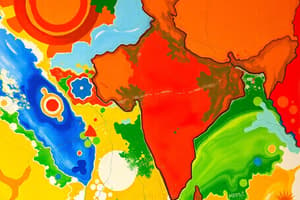Podcast
Questions and Answers
Which event was pivotal in the spread of revolutionary ideas across Europe?
Which event was pivotal in the spread of revolutionary ideas across Europe?
- The French Revolution (correct)
- The Industrial Revolution
- The American Civil War
- World War I
Which ideology was primarily associated with the Russian Revolution?
Which ideology was primarily associated with the Russian Revolution?
- Fascism
- Capitalism
- Socialism (correct)
- Liberalism
What was a significant impact of colonialism on forest societies?
What was a significant impact of colonialism on forest societies?
- Increased population of forest dwellers
- Increased land availability for indigenous people
- Improvement of traditional hunting practices
- Exploitation and deforestation of resources (correct)
Which physical feature of India primarily affects its climate?
Which physical feature of India primarily affects its climate?
Which factor is most directly associated with the distribution of wildlife in India?
Which factor is most directly associated with the distribution of wildlife in India?
Flashcards are hidden until you start studying
Study Notes
Unit 1: India and the Contemporary World-I (History)
Section I: Events and Processes
- The French Revolution: Initiated in 1789, it aimed to overthrow monarchy and establish a republic, emphasizing principles of liberty, equality, and fraternity. It inspired global democratic movements.
- Socialism in Europe and the Russian Revolution: Emerged as a response to industrial capitalism; the Russian Revolution of 1917 led to the establishment of the first socialist state, significantly influencing global politics.
- Nazism and the Rise of Hitler: The Nazi Party, led by Adolf Hitler, rose to power in the 1920s-30s, promoting extreme nationalism and anti-Semitism, ultimately leading to World War II and the Holocaust.
Section II: Livelihoods, Economies and Societies
- Forest Society and Colonialism: Colonial powers exploited forest resources, disregarding local communities and their sustainable practices, leading to significant ecological and social changes.
- Pastoralists in the Modern World: Pastoral nomadism faces challenges from modernization, land encroachments, and climate change, impacting traditional lifestyles and economies.
Unit 2: Contemporary India-I (Geography)
- India-Size and Location: The seventh-largest country, covering approximately 3.287 million square kilometers, located in South Asia, bordered by countries like Pakistan, China, and Nepal.
- Physical Features of India: Diverse landscapes including the Himalayan mountain range, Indo-Gangetic plains, and extensive coastal regions, contributing to varied climatic and ecological conditions.
- Drainage: Major river systems include the Ganges, Brahmaputra, and Indus, crucial for agriculture, transport, and sustaining ecosystems.
- Climate: India experiences a diverse climate ranging from tropical in the south to temperate in the north, characterized by distinct monsoon seasons affecting agriculture and water resources.
- Natural Vegetation and Wildlife: Rich biodiversity with tropical rainforests, deciduous forests, and grasslands; home to numerous endangered species and national parks promoting conservation.
- Population: Over 1.4 billion people, making it the second-most populous country; the population exhibits significant diversity in languages, cultures, and religions, impacting social dynamics and economic development.
Studying That Suits You
Use AI to generate personalized quizzes and flashcards to suit your learning preferences.




